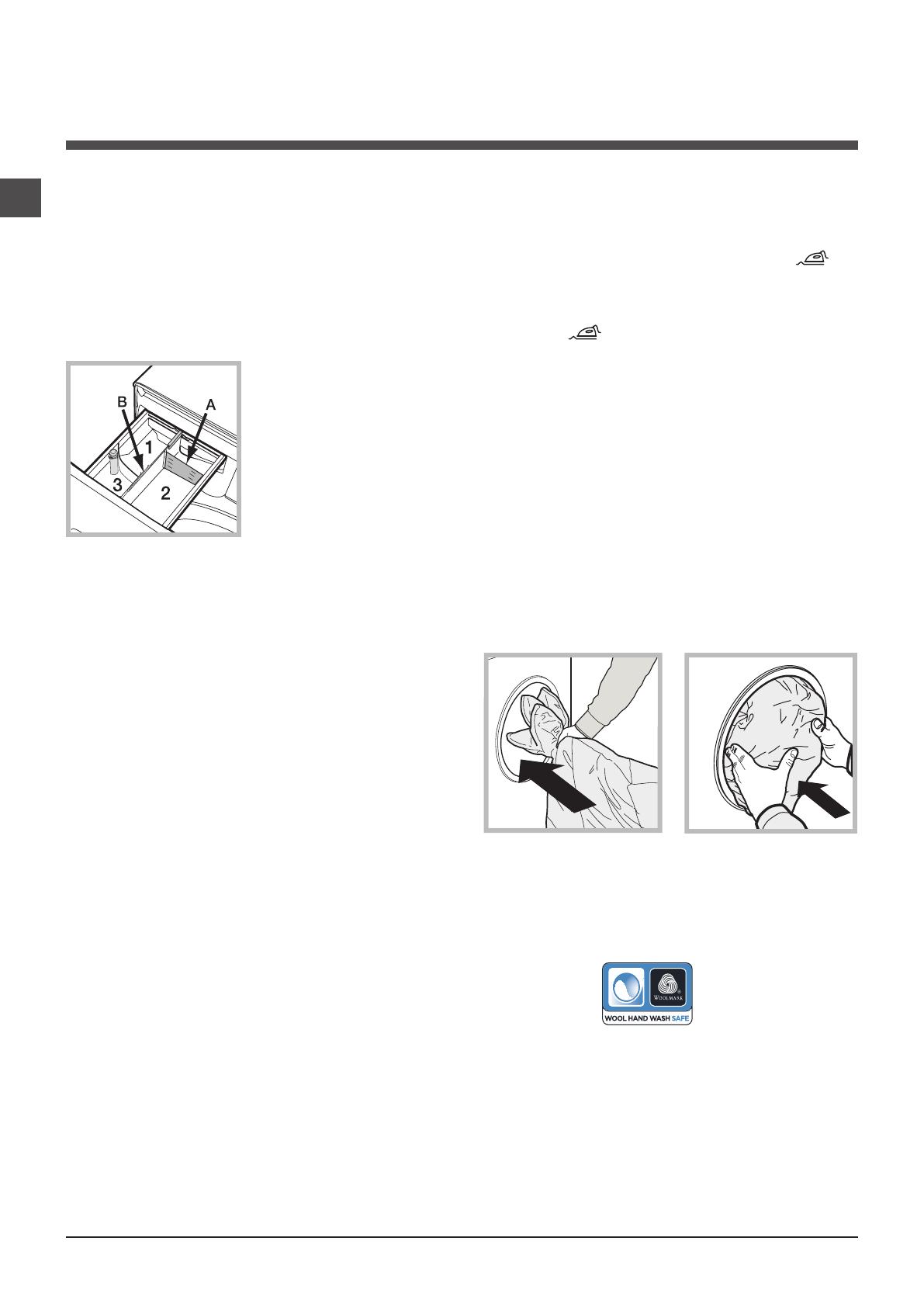
10
GB
Detergents and laundry
Detergent dispenser drawer
Successful washing results also depend on the correct
dose of detergent: adding too much detergent will not
necessarily result in a more efficient wash, and may in fact
cause build up on the inside of your appliance and contri-
bute to environmental pollution.
! Do not use hand washing detergents because these
create too much foam.
! Use powder detergent for white cotton garments, for pre-
washing, and for washing at temperatures over 60°C.
! Follow the instructions given on the detergent packaging.
Open the detergent dispenser
drawer and pour in the deter-
gent or washing additive, as
follows.
Compartment 1: Do not pour detergent into the middle
compartment 1.
Compartment 2: Washing detergent (powder or liquid)
If liquid detergent is used, it is recommended that the remo-
vable plastic partition A (supplied) be used for proper dosage.
If powder detergent is used, place the partition into slot B.
Compartment 3: Additives (fabric softeners, etc.)
The fabric softener must not exceed the “max” level indicated
on the central pin.
Preparing the laundry
• Dividethelaundryaccordingto:
- the type of fabric/the symbol on the label
- the colours: separate coloured garments from whites.
• Emptyallgarmentpocketsandcheckthebuttons.
• Do not exceed the valueslisted in the “Table of wash
cycles”, which refer to the weight of the laundry when dry.
How much does your laundry weigh?
1 sheet 400-500 g
1 pillow case 150-200 g
1 tablecloth 400-500 g
1 bathrobe 900-1.200 g
1 towel 150-250 g
Garments requiring special care
Daily cotton: a 30°C cycle for cotton garments. It allows
for reducing consumption of energy for heating the water,
while guaranteeing excellent results. Suitable for lightly soiled
garments.
Daily synthetics: a 30°C cycle for synthetic garments. It
allows for reducing consumption of energy for heating the
water, while guaranteeing excellent results. Suitable for lightly
soiled garments.
Coloureds: a 30°C cycle that helps to preserve the colours;
suitable for coloured cotton and synthetic garments. It allows
for reducing consumption of energy for heating the water,
while guaranteeing excellent results. Suitable for lightly soiled
garments.
Delicates: use programme 4 to wash very delicate
garments. It is advisable to turn the garments inside out
before washing them. For best results, use liquid detergent
on delicate garments. For washing Silk items and Curtains,
select the relevant cycle and activate the option ; the
machine will end the cycle with the laundry soaked and
the indicator light will flash. To drain the water so that the
laundry can be removed, press the START/PAUSE button
ro the option .
Mixed: a 40°C cycle for washing cotton and synthetic
garments together. Suitable for lightly soiled underwear.
Sport (programme 11) is designed for washing lightly soiled
sports clothing (tracksuits, shorts, etc.); for best results, we
recommend not exceeding the maximum load indicated in the
“Programme table”. We recommend using liquid detergent,
and adding the amount suitable for a half-load.
Duvet: to wash double or single duvets (the weight of which
should not exceed 3.5 kg), cushions or clothes padded with
goose down such as puffa jackets, use the special wash
programme number 12. We recommend that duvets are
placed in the drum with their edges folded inwards (see
figure) and that no more than ¾ of the total volume of the
drum is used. To achieve the best results, we recommend
that a liquid detergent is used and placed inside the detergent
dispenser drawer.
Wool - Woolmark Apparel Care - Blue:
the wool wash cycle of this machine has been approved by
The Woolmark Company for the washing of wool garments
labelled as “hand wash” provided that the products are
washed according to the instructions on the garment label
and those issued by the manufacturer of this washing
machine. (M1127)
In UK, Eire, Hong Kong and India the Woolmark trade mark
is a Certification trade mark.
Anti odour: use programme 14 (Synthetics) for washing
garments with bad odours (e.g. smoke, sweat, fried food).
The programme is designed to remove bad odours while
preserving the fabric fibres.











